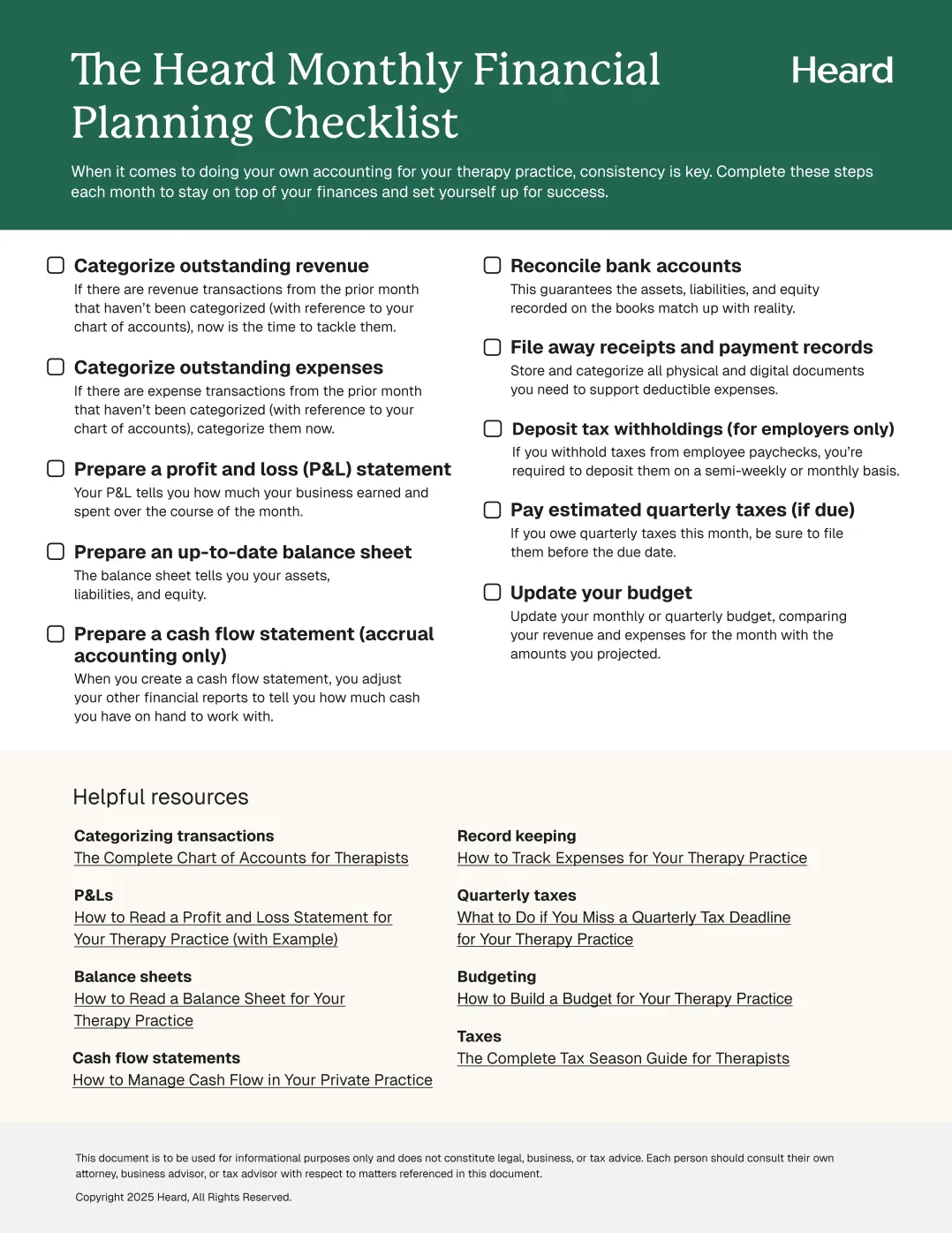Building a profitable therapy practice isn’t just about stacking money.
It’s about creating a business that pays you what you deserve to earn, gives you financial security, and sets you up to offer clients the best treatment you can provide.
In this article, you’ll learn how to plan for an income that suits your needs, while setting important boundaries in terms of your work hours.
You’ll learn how to measure your therapy practice’s profit and some tips keep your business in the black.
{{consult}}
As a therapist, how much do you need to earn?
Before you can build a profitable private practice, consider how much personal income you need to earn.
This is distinct from business income, which goes to covering expenses like:
- Office and and utilities
- Transport to and from work
- Subscriptions, books, and continuing education
- Scheduling and billing apps
- Bookkeepers and accountants
- Insurance
Any profit remaining after you cover these expenses can either be kept as retained earnings (equity in your business), or taken as an owner’s draw or salary.
Many therapists who run solo practices find it easy enough to dip into their business bank account and take owner’s draws as needed. This approach works—until your practice has a slow month, or an unexpected personal expense comes your way.
The best approach is to set a regular owner’s draw or salary that covers your needs. Remember, in a solo practice, you are your practice’s number one asset. Your practice is only able to keep running if you are able to work—if you’re healthy and happy.
Giving yourself a regular payment—weekly, bi-weekly, or even monthly—makes it easier to budget, and make plans for earning a profit.
How to set your fees for therapy
Besides the need to earn enough to both cover your business expenses and pay yourself a reasonable income, there are four factors affecting the fees you set for therapy: target clientele, business goals, market forces, and your earnings timeline.
Target clientele
Who are the clients you’re serving?
For instance, if you specialize in serving clients in lower income brackets, you’ll need to set your fees to make them affordable.
Or, as part of your practice, you may offer career coaching—in which case, you may be working with lawyers or CEOs, who are able to pay more.
You don’t always choose your target clientele, however. That’s particularly the case if you offer local, in-person sessions only. If you’re in a low-income area, you may need to keep lower fees, in order to make your services affordable.
Or you may serve an area where almost everyone has insurance coverage, in which case you may need to be paneled out of necessity, and earn fees set by insurance networks.
Business goals
If you’ve created a business plan for your private practice, it should include goals for the future.
Five years from now, do you want to:
- Join other therapists in a group practice?
- Move to a bigger office?
- Have X number of dollars in your savings account?
- Relocate to a different city or state?
- Upgrade your education and skills?
- Hire employees to handle admin?
Planning for any of these goals includes making financial projections (something an accountant can help with). Those projections will partly determine the fees you set for your practice.
You’ve probably seen programs and courses for building a “six figure practice.” Making six figures as a therapist is great, but it doesn’t need to be the goal for everyone. Set business goals that meet your needs.
Market forces
Researching what other therapists in your area are charging will give you a sense of how much you should charge.
Market forces—like location, demand, and the current state of the wider economy—not only determine other therapists’ fees. Their fees are a market force themselves. You’ll need to set your fees in order to remain competitive, without underpaying yourself or running the risk of bankrupting your practice.
Earnings timeline
Do you plan to earn the same amount of income every year for the foreseeable future, or do you expect it to increase?
Deciding how much you’d like to be earning in personal income five years and ten years from now helps you plan any fee increases in the future, as well as setting fees now. And it can help you plan moves you need to take immediately—whether getting new clients, changing clientele, or opening up alternative streams of revenue—to make it happen.
Learn more from our article on how to set fees for your private practice (including three mistakes to avoid).
How to set your work hours
Your work hours are different from your hours of business.
Your hours of business provide the window in which you set appointments with clients. Having set hours of business allows you to take care of important personal affairs, like eating and sleeping. Your work hours are equal to the total amount of time you spend each week seeing clients.
It’s important to set both business and work hours for your therapy practice. From a financial point of view, working for your own business can be incredibly rewarding and empowering.
As you begin to see your profits grow, and your hard work translates into cash in the bank, it’s all too easy to take on more than you can manage.
This can result in increasingly blurred lines between work and personal life, and, eventually, burnout.
If you’re just starting your practice, you may be tempted to believe that a 40-hour workweek means 40 hours with clients. For most therapists, this is not realistic. There are hard limits on how much time per week you can spend with clients.
Typically, a “full caseload” for a therapist in private practice is 20-25 clients per week.
Hard limits on your therapy practice
If you run a factory or a store, the only hard limit on your earnings is demand.
For instance, say your novelty coffee mug factory creates 10,000 mugs per month, and sells them at a 100% profit. If you want to make more money, you find new customers: Sell 20,000 mugs per month, and you make that much more money. So long as demand goes up, you can keep expanding your factory and hiring more workers.
The same goes for the homewares store that buys your mugs wholesale, and sells them at retail price. They can hire more workers and expand the store to accommodate growing demand, and increase their revenue as a result.
But let’s say you’re a therapist with a client list of 30 people, who see you on a weekly and bi-weekly basis. Suppose you place an ad for your practice in the local paper, and it’s wildly successful. You’re overwhelmed with requests for consultations.
Can you increase your client list to 40 people? How about 50 or 60? What’s the limit?
Calculating your work hours
The standard workweek is forty hours. So, in theory, you could have forty clients, who you see weekly for one hour each, and you’d be at your maximum limit. Right?
Not exactly. Forty client hours per week doesn’t include time for documentation and administrative work (e.g. bookkeeping).
In her book Money-Smart Secrets for the Self-Employed, Linda Stern offers a formula therapists can use to calculate how many billable hours they can work per year.
Billable hours for a therapist in one year
If you use the formula above, you can work an average of just over 35 billable hours per week. Or if you only work 49 weeks per year, just shy of 38 hours per week.
But then you need to take into account the time cost not just of seeing clients, but of running your business:
Billable hours for a therapist in one year (cont.)
When you take into account the time you spend keeping your business running (based on Stern’s recommendations), you end up with 26 billable hours per week, for 49 weeks of the year.
How much do you need to earn per hour to cover business expenses, pay federal and state taxes, and pay yourself a livable wage?
{{consult}}
How to measure your therapy practice’s profitability
It’s hard to build a profitable business if you’re not sure what a profitable business looks like. Profit and loss statements (P&Ls) are the most reliable way to measure your therapy practice’s profitability. But it’s important to have a clear definition of profit in the first place.
What is profit?
Gross profit is the amount your therapy practice has earned before taking into account expenses. Net profit is the amount you’ve earned once you take expenses into account.
For instance, if clients paid you a total of $3,000 last month, your gross profit is $3,000. If your expenses for the month were $1,200, your net profit is $1,800.
Your net profit margin is the amount you’ve earned for a particular period relative to how much you’ve spent.
Net profit / Revenue = Net profit margin
Using our example earnings from above:
$1,800 / $3,000 = 0.6
Expressed as a percentage, your net profit margin is 60%.
By tracking your net profit each month, and calculating your profit margin, you can get a sense of how profitable your business is, and how its profitability changes over time.
But it’s hard to make strategic moves for increasing your profit margin—like cutting expenses, or increasing your fees—unless you have a more detailed breakdown of what you’ve earned and what you’ve spent. That’s where P&Ls come in.
Reading profit and loss statements (P&Ls)
Using accounting software like Heard, or with help from a qualified bookkeeper, you can generate P&Ls for your business on a monthly, quarterly, or annual basis.
A P&L is a type of financial report. Along with the balance sheet and cash flow statement, it forms the three key financial statements for running your business.
The P&L is generated by taking money from your general ledger—the place where you track all your business transactions—to create a financial report that breaks down your income and expenses into different categories, so you can see both how your practice is earning money and how you’re spending it.
For a complete guide to P&Ls, check out our guide on how to read a profit and loss statement for your therapy practice.
How to make your therapy practice more profitable
Creating P&Ls for your private practice, and tracking how your profitability changes over time, is a great way to see how you’re earning (and spending) money.
But just reading a P&L won’t help you make more money. If your business needs to earn more profit—either in order to build up savings, or to pay you a reasonable wage—it’s up to you to take action.
Here are a few simple ways you can increase your therapy practice’s profitability.
Create a budget
A budget is like a road map to profit. When you create a budget for your therapy practice, you’re effectively planning how much you’ll need to earn during a particular period, plus how low you’ll need to keep your expenses, in order to reach your profit goals.
Once the period covered by a business budget has passed, you enter the amount you really earned and really spent, so you can see where you did a good job of staying on budget, and where there’s room for improvement in the future. This information also informs the next budget you create.
The result is a feedback loop of (hopefully) more accurate budgeting, giving you insight into how your business runs, and moves you can make to increase profitability. For a deeper dive, see our article on how to build a budget for your therapy practice.
Reduce overhead
Overhead consists of the recurring expenses you need to cover every month in order to stay in business. For a solo therapy practice, those typically include:
- Rent
- Billing, scheduling, and listing services
- Web hosting fees
- Phone
- Insurance
- Business license
In most cases, your overhead is stable. It stays the same month to month. And since it’s stable and recurring, small changes can have a large cumulative effect.
For instance, suppose your office lease is up for renewal, but instead of renewing it, you opt to move to another office nearby that costs $200 less in rent per month.
In one year, that’s a savings of $2,400. Everything else being equal, you’ve increased your annual profits by $2,400. In five years, that’s $12,000.
Relatively minor changes like this add up. Keeping a lookout for ways you can save on overhead—and making changes when the time is right—will help you gradually grow your profit margin.
Outsource tasks
Some tasks you do to keep your therapy practice running are literally more trouble than they’re worth. To see how, try applying your hourly rate to admin work.
Suppose you earn $90 per hour seeing clients. And each week you spend two hours filling out insurance claims.
If you didn’t have to spend those extra two hours per week, you could take on an additional one hour appointment per week. Budget the “leftover” hour for catching up on session notes, billing, and doing any other admin that comes with bringing on a new client.
That’s an extra $90 per week, or $360 per month. When you begin to look at your admin work this way—as time that could be converted to hours with clients—you may find a lot of potential extra profit tied up in office tasks.
Bookkeeping, accounting, and tax filing are all good examples of back office tasks that eat into your potential profit-making hours. Hundreds of therapists find it saves them money to pay for Heard rather than spending time on these financial tasks themselves.
Find ways to reduce your tax bill
By saving receipts and tracking expenses, you can take advantage of tax deductions, and may be able to significantly reduce your tax bill.
Our complete list of tax deductions for therapists has a ton of suggestions. But be sure to get guidance from an accountant when deciding which deductions to take advantage of. Not only will they be able to suggest deductions you may have missed, they’ll ensure you only take the deductions you really qualify for, so you won’t run afoul of the IRS.
Revisit your fees
Here are some signs you may want to consider raising your hourly rate.
You’re having trouble covering personal expenses. This could be due to personal expenses increasing because of life events (buying a house, having a baby), or it could be that you underestimated personal expenses when you set your fee in the first place.
Business expenses have increased. Moving to a new office space, hiring part-time employees to help with admin, or simply facing increases in rent and the cost of utilities can all cut into your bottom line, and necessitate an increase in fees.
You upgraded your skills. Additional training and continuing education not only increase your value as a therapist, but they’re business expenses that need to be covered.
You want more committed clients. In some cases, increasing your fees can actually make your existing clients more diligent. If you’ve been charging an entry-level price for your services, a move to higher fees may nudge your clients to take their work in therapy more seriously, and commit to positive changes.
You have a waiting list. If you’re overwhelmed with referrals, an increase in fees can slow them down a bit, and take pressure off you. At the same time, if you have a growing waiting list, you may be able to afford the risk of losing less-committed clients in the event you increase your fees.
You need to keep up with inflation. One dollar in 2010 would be equivalent to $1.34 in 2022. If your practice was operating from 2010 – 2022, and you never adjusted your fees, you’d be putting yourself at a serious disadvantage. Keeping an eye on inflation is important in the long-term for adjusting your fees.
You want a raise. You deserve to enjoy some of the benefits of running a successful business. Paying yourself a higher salary can increase your self-esteem, and cool down any simmering resentment you may feel as a result of underpaying yourself.
—
Can’t decide on an hourly rate? Considering an increase? Check out our article on how to set fees for your therapy practice.
This post is to be used for informational purposes only and does not constitute legal, business, or tax advice. Each person should consult their own attorney, business advisor, or tax advisor with respect to matters referenced in this post.
Bryce Warnes is a West Coast writer specializing in small business finances.
{{cta}}
Manage your bookkeeping, taxes, and payroll—all in one place.

Discover more. Get our newsletter.
Get free articles, guides, and tools developed by our experts to help you understand and manage your private practice finances.
Maximize your tax savings and build a profitable therapy practice with Heard. Book a free consult to learn more.
Schedule a free consult




